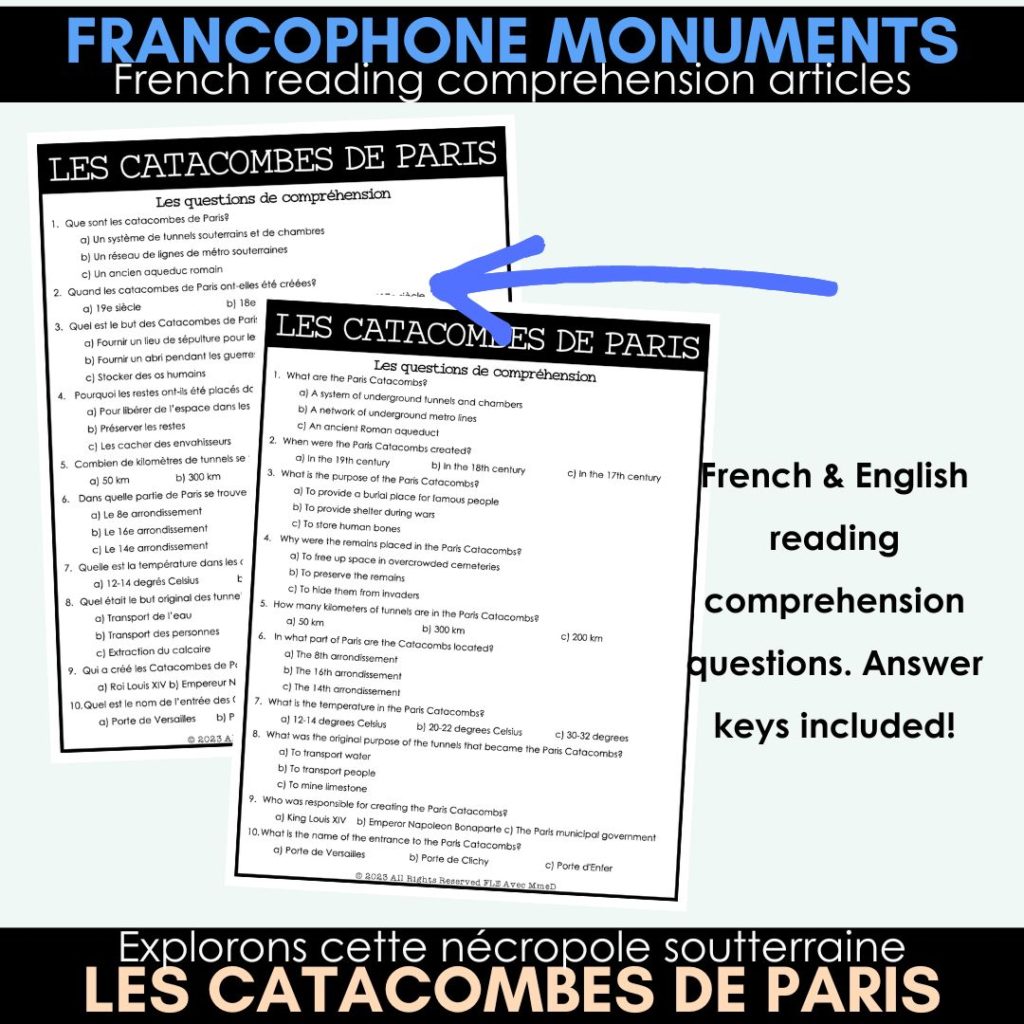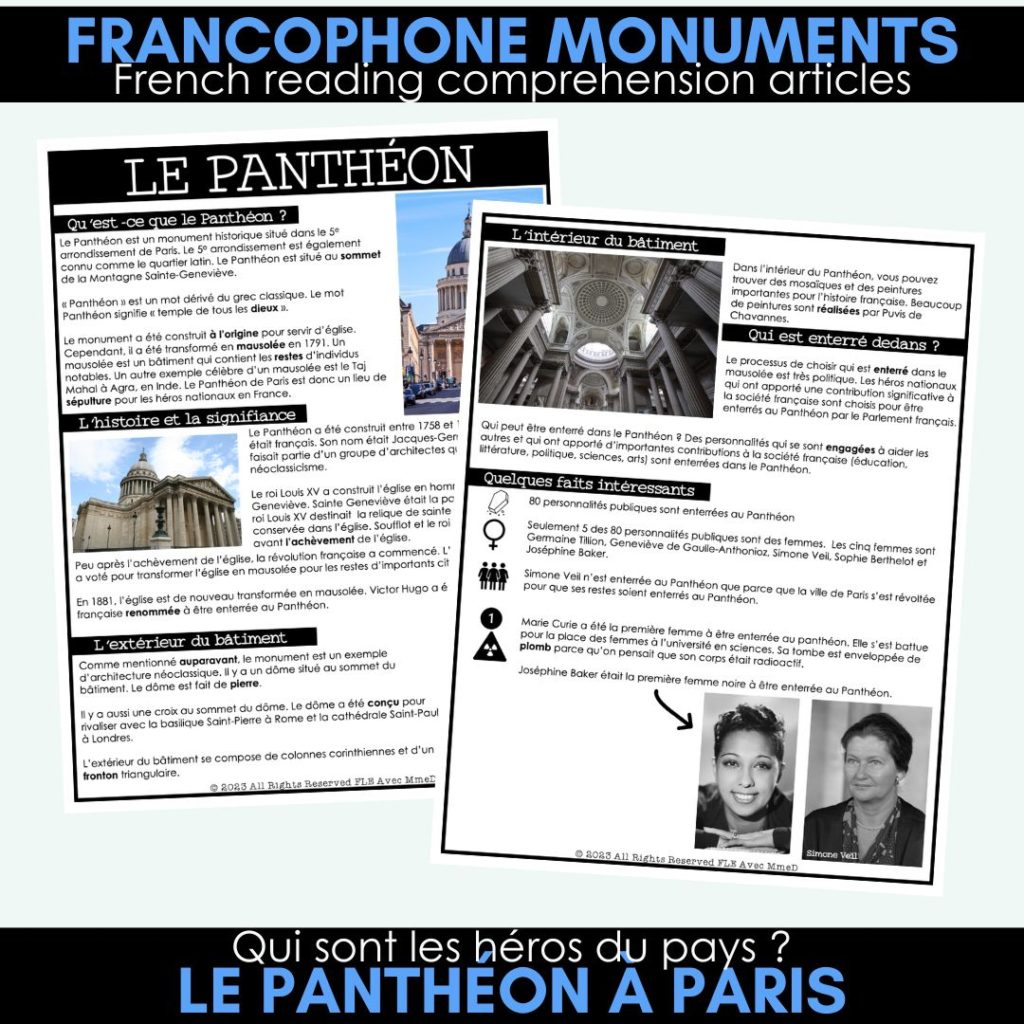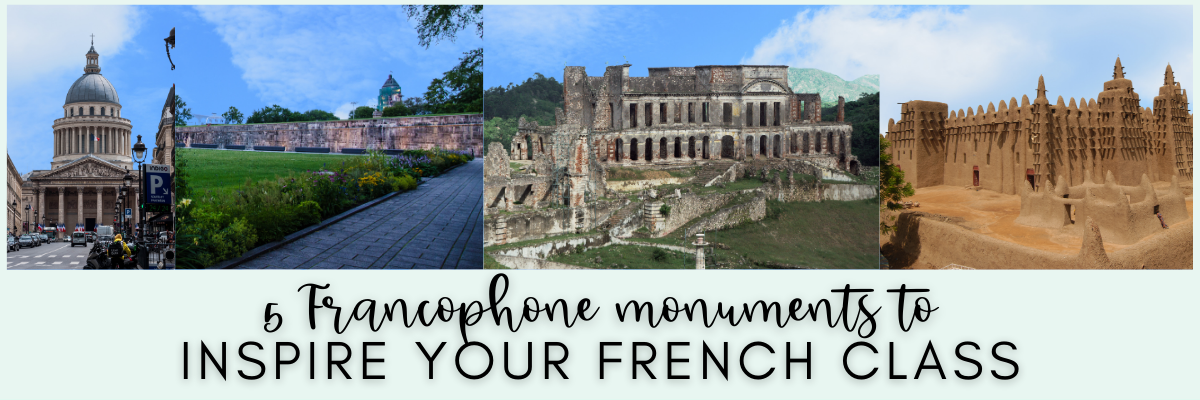
From Djenne Mosque to Citadelle La Ferrière, here are five Francophone monuments to inspire your French classroom. In this blog post, I am going to be sharing five diverse Francophone monuments you can teach your Core French or French Immersion students about!
If you are looking for ready-made resources on the five Francophone monuments, I’ve got you covered with prep-free & ready-to-print French reading comprehension articles for intermediate to advanced Core French or French Immersion students.
Before we begin, why is the structure of the French reading comprehension articles ideal for learners?
All of the articles in this series follow a very specific structure. I have designed these strategies to build confidence among my Core French learners in the knowledge that they already have. You can read about these French reading comprehension strategies in this blog post.
Each article comes with :
- pre-reading activities
- 2-page article
- reading comprehension questions (English & French options)
- One extension activity per article
- Answer keys


La Citadelle de Quebec – a historic francophone monument in Quebec City
To begin, in this French reading comprehension article, Core French or French Immersion students will learn about the history of La Citadelle de Québec. Explore not only the Citadelle, but also the surrounding historic neighbourhood with your French class.

But first, what is the Citadelle? Did you know that…
- The Citadelle de Quebec is an active military installation. It is also the official residence of the Royal 22nd Regiment, the only French-language regiment in the Canadian Armed Forces.
- It is also the official home of the Governor General of Canada.
- The Citadelle de Québec is home to the largest military music school in Canada (I didn’t even know this!). The Royal 22nd Regiment Band consists of full-time musicians who provide music for official military ceremonies, parades, and concerts throughout Quebec and the rest of Canada.
- The Citadelle is one of the best-preserved fortifications in North America. The British Army built the Citadelle to protect the city of Quebec from an American invasion following the War of 1812.
- Finally, the Citadelle is a popular tourist attraction in Quebec. It is also a National Historic Site of Canada.
Les Catacombes de Paris
This particular article is a perfect French Halloween activity. However, you don’t have to wait for l’Halloween, you can also read up on this Parisian monument any time of the year. If you’re looking for built-in French Halloween vocabulary for your students, this article is perfect for your French class.
Here are some facts about the Catacombs. Did you know that…
- The Paris Catacombs contain the remains of an estimated 6 million people. It is therefore one of the largest mass graves in the world. Paris city officials transferred the remains to the catacombs from overcrowded cemeteries in Paris in the late 18th and early 19th centuries.
- The underground tunnels of the catacombs span over 200 miles (322 km), but only a small section of the tunnels is open to the public. The section that is open to visitors is about 1.5 miles (2.4 km) long and takes about 45 minutes to walk through.
- During World War II, the
- French Resistance used the Paris Catacombs as headquarters. The Resistance fighters used the tunnels to hide from German soldiers and to transport supplies and weapons.

Le Panthéon en France
I am ashamed to admit that I have only recently learned about the Panthéon myself as a French teacher. Now that I’ve learned about it, I find it fascinating. I like to focus on the very few women and people of colour honoured in the Panthéon. You don’t have to wait for Black History Month or International Women’s Day to talk about systemic racism and patriarchy in your French class.

Did you know that…
- The Paris Pantheon was originally a church dedicated to St. Genevieve, the patron saint of Paris. However, during the French Revolution, it was turned into a mausoleum for famous French figures, including Voltaire, Rousseau, Victor Hugo, and Marie Curie.
- The dome of the Paris Pantheon is inspired by the dome of St. Peter’s Basilica in Rome. It is 83 meters (272 feet) tall and is one of the highest points in Paris. Visitors can climb to the top of the dome for stunning views of the city.
- The crypt of the Paris Pantheon contains the tombs of over 70 notable French figures, including scientists, writers, politicians, and artists. The oldest tomb in the crypt belongs to French philosopher and mathematician René Descartes, who died in 1650.
La Grande Mosquée de Djenné au Mali – a historic Francophone monument in West Africa
Francophone Africa should be studied year-round in French classes for it’s cultural richness. Here is one particular Francophone monument you and your French students should absolutely learn about!
Did you know that…
- The Great Mosque of Djenne is thought to be one of the greatest examples of Sudano-Sahelian architecture. This type of architecture is characterized by the use of mud bricks and wooden beams. The mosque is made entirely of mud and is the largest mud-brick building in the world.
- The Great Mosque of Djenne was first built in the 13th century, but the current structure dates back to 1907. The residents of Djenné rebuild the mosque every year during the Festival of Crepissage. This is a traditional ceremony in which the community comes together to repair the mud plaster on the mosque’s walls.
- The Great Mosque of Djenne is located in the city of Djenne in Mali. The mosque and mud-built town surrounding the mosque are UNESCO World Heritage Sites. Djenne is also a symbol of Islam in West Africa.

Citadelle La Ferrière en Haïti

Did you know that…
- Henri Christophe, one of the leaders of the Haitian revolution, commissioned Citadelle La Ferriere. Henri Christophe built the fortress to protect Haiti from French invasion and is one of the largest fortresses in the Americas.
- The Citadelle La Ferriere is located on top of a mountain in northern Haiti and is accessible only by foot or on horseback. It is surrounded by a massive defensive wall that is up to 130 feet (40 meters) high and 10 feet (3 meters) thick.
- The Citadelle La Ferriere is considered one of the most impressive military fortresses in the world. It is a UNESCO World Heritage Site.
- Finally, it is also a symbol of Haitian independence.
I hope you have been inspired by these incredible Francophone monuments!
If you are interested in using these articles with your French class, click the button below to check them out.


